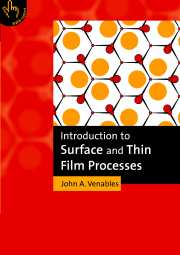Book contents
- Frontmatter
- Contents
- Preface
- Chapter 1 Introduction to surface processes
- Chapter 2 Surfaces in vacuum: ultra-high vacuum techniques and processes
- Chapter 3 Electron-based techniques for examining surface and thin film processes
- Chapter 4 Surface processes in adsorption
- Chapter 5 Surface processes in epitaxial growth
- Chapter 6 Electronic structure and emission processes at metallic surfaces
- Chapter 7 Semiconductor surfaces and interfaces
- Chapter 8 Surface processes in thin film devices
- Chapter 9 Postscript – where do we go from here?
- Appendix A Bibliography
- Appendix B List of acronyms
- Appendix C Units and conversion factors
- Appendix D Resources on the web or CD-ROM
- Appendix E Useful thermodynamic relationships
- Appendix F Conductances and pumping speeds, C and S
- Appendix G Materials for use in ultra-high vacuum
- Appendix H UHV component cleaning procedures
- Appendix J An outline of local density methods
- Appendix K An outline of tight binding models
- References
- Index
Chapter 3 - Electron-based techniques for examining surface and thin film processes
Published online by Cambridge University Press: 06 July 2010
- Frontmatter
- Contents
- Preface
- Chapter 1 Introduction to surface processes
- Chapter 2 Surfaces in vacuum: ultra-high vacuum techniques and processes
- Chapter 3 Electron-based techniques for examining surface and thin film processes
- Chapter 4 Surface processes in adsorption
- Chapter 5 Surface processes in epitaxial growth
- Chapter 6 Electronic structure and emission processes at metallic surfaces
- Chapter 7 Semiconductor surfaces and interfaces
- Chapter 8 Surface processes in thin film devices
- Chapter 9 Postscript – where do we go from here?
- Appendix A Bibliography
- Appendix B List of acronyms
- Appendix C Units and conversion factors
- Appendix D Resources on the web or CD-ROM
- Appendix E Useful thermodynamic relationships
- Appendix F Conductances and pumping speeds, C and S
- Appendix G Materials for use in ultra-high vacuum
- Appendix H UHV component cleaning procedures
- Appendix J An outline of local density methods
- Appendix K An outline of tight binding models
- References
- Index
Summary
This book presumes that the reader is interested in experimental techniques for examining surface and thin film processes; however, there are many books devoted to surface physics and chemistry techniques, some of which are given as further reading at the end of the chapter. There are even several books which are just about one technique, such as Pendry (1974) or Clarke (1985), both on low energy electron diffraction (LEED) in relation to surface crystallography. By the mid-1980s it was already stretching the limits of the review article format to compare the capabilities of the available surface and thin film techniques (Werner & Garten 1984).
Since then, the various sub-fields have proliferated, so we cannot be comprehensive, or give all the latest references here. In section 3.1 we discuss ways of classifying the large number of techniques which exist, and thereafter the chapter is restricted to techniques based on the use of electron beams. Section 3.2 discusses the most widely used (elastic scattering) diffraction techniques used for studying surface structure. Section 3.3 discusses forms of electron spectroscopy based on inelastic scattering, which are used to obtain composition and chemical state information. Individuals can look in more detail into a particular technique. Students have been asked to present a talk to the class, followed by questions and discussion; some of the topics considered in this way are listed, along with selected problems, at the end of the chapter. As examples, some case studies are given in section 3.3 on Auger electron spectroscopy, in section 3.4 on quantification of AES, and in section 3.5 on the development of secondary and Auger electron microscopy.
Information
- Type
- Chapter
- Information
- Introduction to Surface and Thin Film Processes , pp. 63 - 107Publisher: Cambridge University PressPrint publication year: 2000
